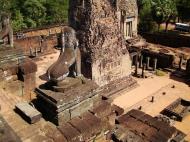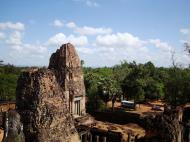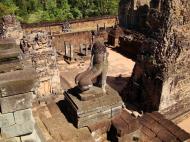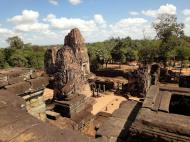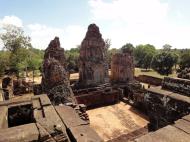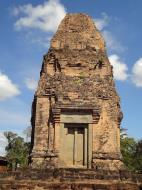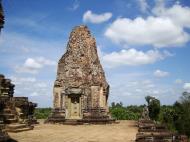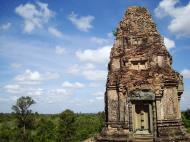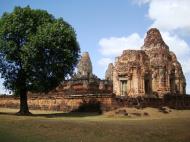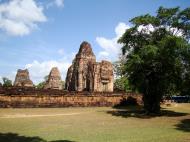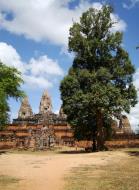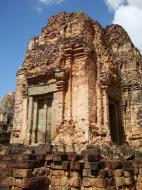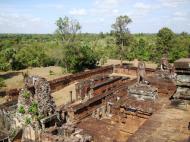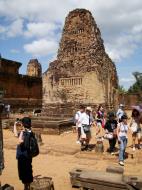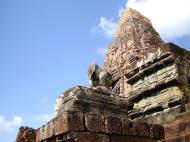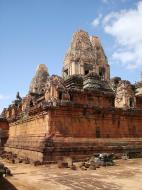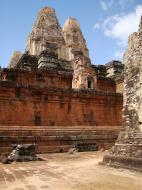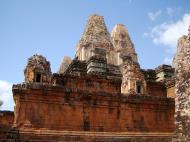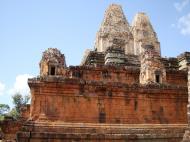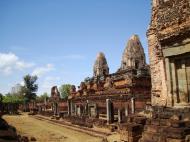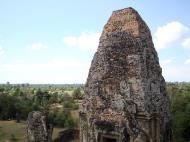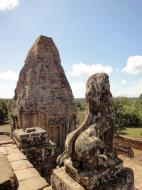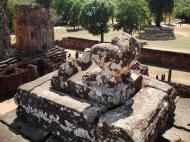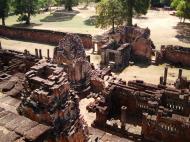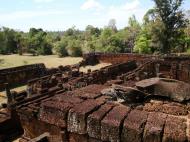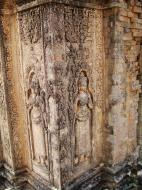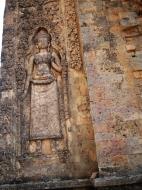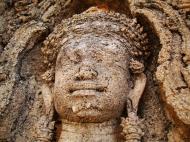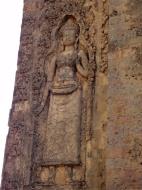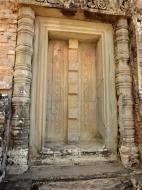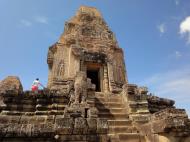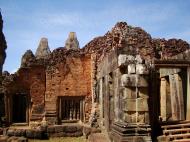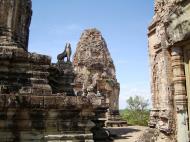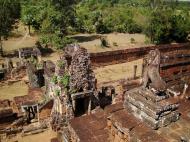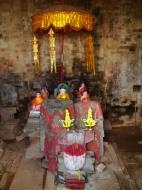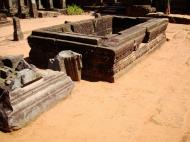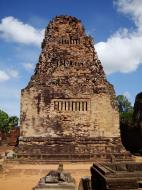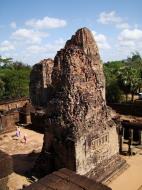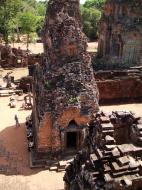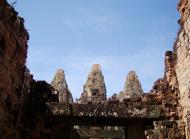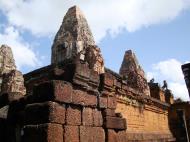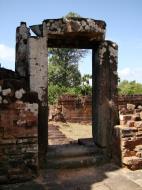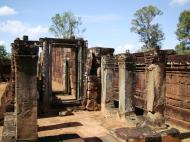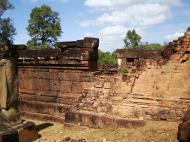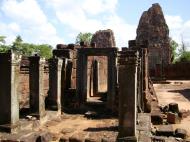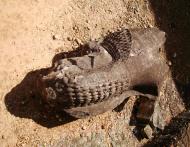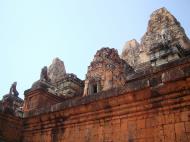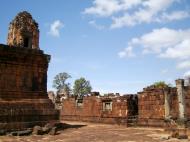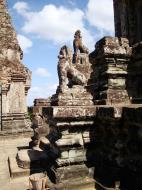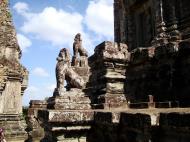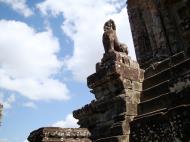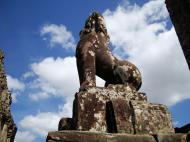Pre Rup Temple - Turn over the body
Date: Second half of the tenth century 961
Reign of construction: Rajendravarman II («ivaloka) 944-967
Cult: Hinduism dedicated to the «iva
Clearance work: H. Marchal and G. Trouvť 1930-1935
Art Style: Pre Rup
Located just south of the East Baray
Coordinates: 13.435473įN 103.920452įEPre Rup Temple - Turn, or change is located at northeast of Srah Srang and 500 meters (1,640 feet) south of the south end of the East Baray. The outer enclosure wall is 127m by 116m; the central terrace forms a square of about 30m each side and about 15m high; 5 towers standing in quincunx.
Two images of women with four arms and one, has four faces and the other a sows head; they are the wives of Brahma and ViÁnu, the latter in the guise of wild boar.
In front of the principal staircase, there is a tank (vat) which was considered by Cambodian people to be the tank in which the legendary personage was cremated; it is a corner stone which must have been topped with rounded pyramid, but it is doubtless made of precious metal and now nothing remains.
Around the pyramid, there are two levels, each surrounded by a laterite hall: 120m by103
A stele which dates 961; this temple was formerly surrounded by moats and had a large entrance on the other side of the new road.The king installed Linga Rajendra BhadreÁvara in the central sanctuary and Linga RajendravarmeÁvara in the north-eastern tower to dedicate to his ancestors.
967 Raja Guru Yajnavaraha - Brahman priest built Tribhuvana MaheÁvara (Banteay Srei) dedicated to the God «iva.
Pre Rup is a temple at Angkor, Cambodia, built as the state temple of Khmer king Rajendravarman and dedicated in 961 or early 962.
Located just south of the East Baray, or eastern reservoir, Pre Rup is aligned on a north-south axis with the East Mebon temple, another creation of the reign of Rajendravarman.
The outer enclosure is a platform bounded by a laterite wall, 117 meters N-S by 127 meters E-W.
A laterite causeway gives entry from the east; unfortunately, a modern road cuts across it.
To either side inside the eastern gate is a group of three towers aligned north to south.
One of the towers appears to have never been built or to have been dismantled later they are later additions, probably by Jayavarman V.
Further ahead, through another gate, libraries lie to either side of the walkway on the second platform.
There are also a series of long distinct galleries which run along each side, a distinctive feature of 10th century architecture that will be substituted by a continuous gallery from Ta Keo onward.
The final squared pyramid, measuring 50 m at its base, rises in three steep tiers a dozen metres in height to a 35 m square platform at the summit.
The lowest tier is symmetrically surrounded by 12 small shrines.
At the top, five towers are arranged in a quincunx, one at each corner of the square and one in the center.
The southwest tower once contained a statue of Lakshmi, the northwest tower a statue of Uma, the southeast tower a statue of Vishnu and the northeast tower a statue of Shiva.
Pre Rup was dedicated to the Hindu god Shiva, and it is probably located on a former shivaite ashram, built by Yasovarman I in the previous century.
An entrance and exit the monument from the east entrance.
To climb to the upper terrace use the east stairway; it is slightly less steep than the others.
Tip: Because the temple is built entirely of brick and laterite, the warm tones of these materials are best are seen early in the morning or when the sun is setting.
There are two views from the top terrace: the first looking east towards Phnom Bok and the mountain chain of Phnom Kulen; and the second looking west where the towers of Angkor Wat can be distinguished on the far horizon.
The boldness of the architectural design of Pre Rup is superb and give the temple fine balance, scale and proportion.
The temple is almost identical in style to the East Mebon, although it was built several yeas later.
It is the last real 'temple-mountain ' Pre Rup was called the 'City of the East ' by Philippe Stern, a Frenchman who worked on the site.
The Cambodians have always regarded this temple as having funerary associations but reason is unknown.
The name Prerup recalls one of the rituals of cremation in which the silhouette of the body of the deceased, outlined with its ashes, is successively represented according to different orientations, some archaeologists believe that the large vat located at the base of the east stairway to the central area was used at cremations.
Pre Rup dominates the vast plain, which the East Baray irrigated.
Contracted on an artificial mountain in laterite with brick towers, the plan is square and comprises two enclosures with four entry towers each and a base with three narrow tiers serving as a pedestal for five towers on the top platform one in each corner and one central.
Inside the outer laterite-enclosing wall there are two groups of three towers, one on each side of the entrance; the towers of each group share a common base.
The middle tower in each of the two groups dominates and is more developed than the others.
It appears that the first tower on the right was never built or, if it was, its bricks were reused somewhere else.
The most complete lintel is on the tower at the far left (south) on the east face showing in his avataras a man-lion.
The next enclosure, also made of laterite, has four small entry towers, one on each side Long galleries surround the courtyard on the enterior.
The walls of the galleries, which have sandstone porches, are built of laterite.
They have sandstone pillars in the east and laterite walls and windows with balusters in the west.
In the northeast corner there is a curious small square building built of large blocks of laterite and open on all four sides.
The inscription of the temple was found in gallery near this building.
On the left and right sides of the east entry tower of the second enclosure there are libraries with high towers.
Central area (base and towers) the square base has a stairway on each side.
Pedestals flanking the stairways are adorned with seated lion of which those on the lower terraces are larger than those on the higher levels.
The first two tiers are built of laterite and have simple supporting walls with a molded base and cornice.
Twelve small temples opening to the east and containing linga are evenly spaced around the first tier.
The upper platform is raised on a double base of molded sandstone with stairway flanked with lions.
The five central towers on the top platform are open to the east.
On the west side of this tower there is another divinity with four arms and heads in the form of a wild boar; it is the wife of Visnu in his avataras as a boar.
Rajendravarman II
Rajendravarman II was the king of the Khmer Empire (region of Angkor in Cambodia), from 944 to 968.
Rajendravarman II was a nephew of former king Yasovarman I.
His principal monuments, located in the Angkor region of Cambodia's Siem Reapprovince, are Pre Rup and East Mebon.
The king claimed links to the royal line of the Chenla state that had its capital at Bhavapura (the city's location is debated) and predates the start of the Khmer empire in 802 A.D.
Inscriptions say that the Khmer empire under his tutelage extended to southern Vietnam, Laos and much ofThailand and as far north as southern China.
An inscription at Pre Rup relates that Rajendravarman II was a great warrior, his sword frequently blood-stained, his body as hard as a diamond.
Though the king punished the guilty, the inscription says, he had an ocean of compassion for the innocent.
Many scholars believe that Rajendravarman II instituted a system of centralized administration, establishing more direct control over a collection of princes who had been largely independent at their estates in the provinces.
Rajendravarman II led fighting against the rival state of Champa in the east, and in 950 A.D. seized as booty a gold statue in the temple of Po Nagar there.
Rajendravarman II was succeeded by his 10-year-old son, who reigned as Jayavarman V.
Angkor's North Gate Siem Reap, Cambodia Map
 Editor for Asisbiz: Matthew Laird Acred
Editor for Asisbiz: Matthew Laird Acred
If you love our website please add a like on facebook
Please donate so we can make this site even better !!







